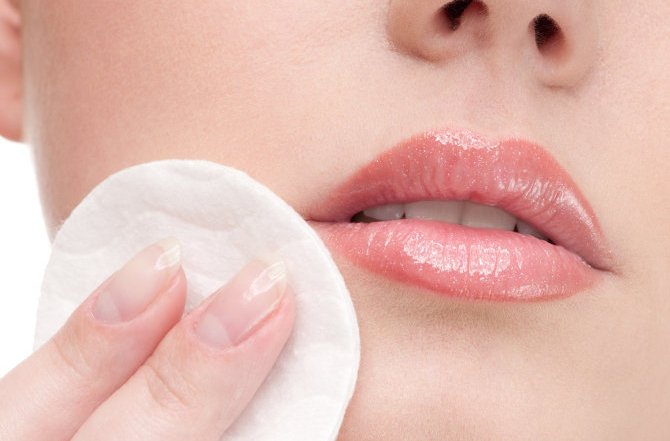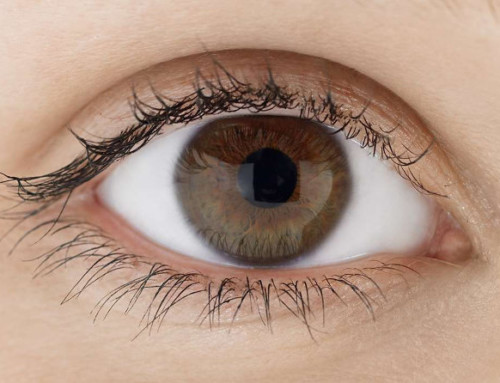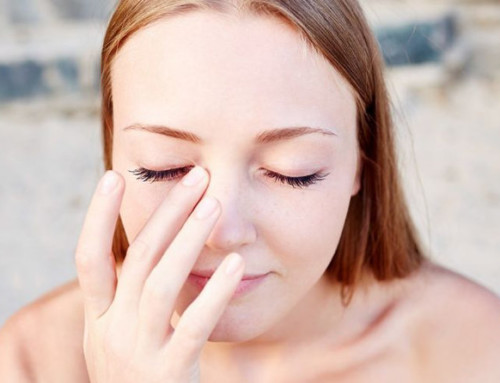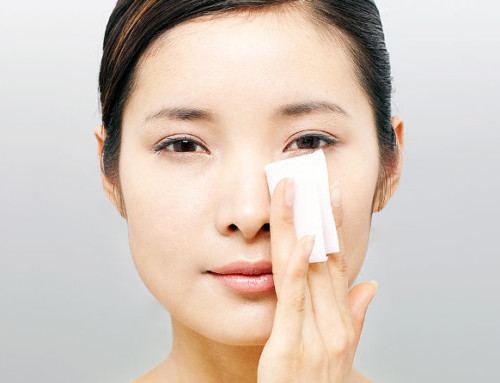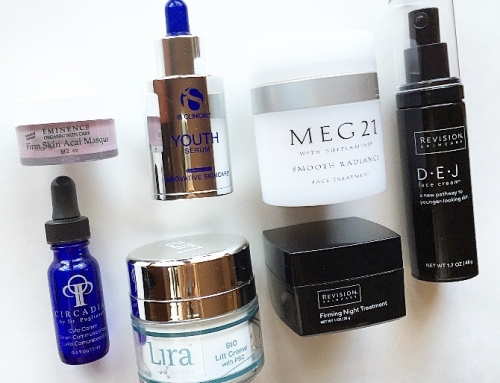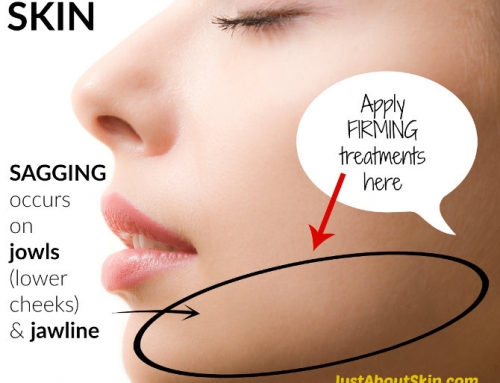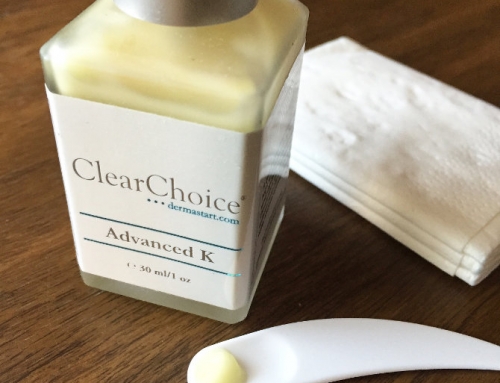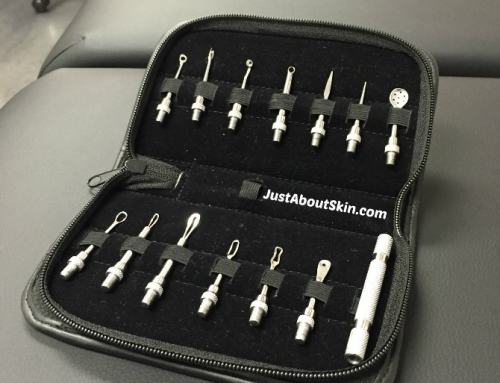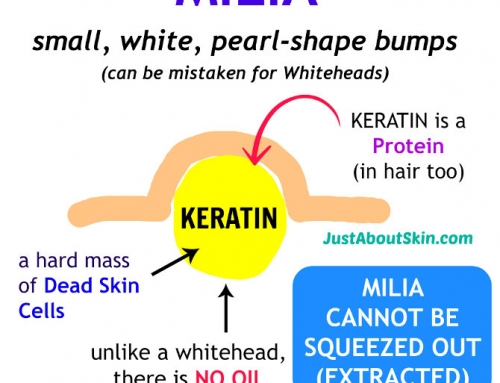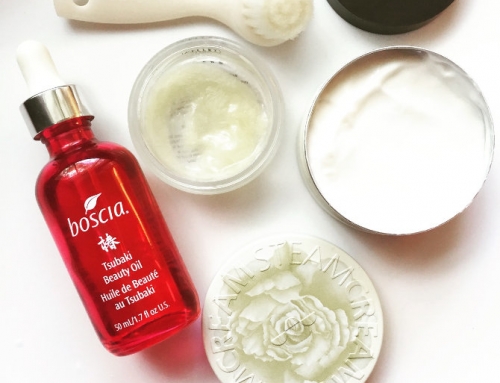Irritated skin is no fun. Do you know what to do if something bad happens to your skin?
One reader asked me for advice on what to do when “exfoliation has gone wrong.” Exfoliation is a common cause of irritation. The wrong exfoliants or techniques can create great discomfort. Hopefully, this has never happened to you.
But irritation can be caused by a wide range of triggers. Unfortunately, it’s quite easy to irritate skin, especially when skin is already weak.
What does irritated skin look like? Well, common signs are skin turning red or pink, skin feeling hot, a burning or stinging sensation, itching, and pain. Skin may develop a rash, or become dry, rough, and cracked.
If you are irritated, you have some amount of inflammation in your skin already. It may be a very small amount (no obvious signs), or it may be intense (your skin is red and burning).
The key thing to do is reduce the inflammation immediately and repair the barrier.
14 Things You Can Do To Treat Irritated Skin
1. Rinse immediately with COLD WATER if you are in pain
If you just put something on your skin and it burns, or if your skin is in pain, stinging unbearably, completely red and the redness isn’t going away after 5-10 min, then:
- Immediately rinse your face with COLD water. Or wipe your face with a soft cotton pad soaked in cold water (not a wash cloth which is too rough).
- Repeat several times. Keep the cotton pad cold.
Rinsing or wiping with cold water will remove the offending product without introducing any new ingredients into skin.
More importantly, water immediately changes the pH of whatever product you have on your skin. It will neutralize an acidic pH. AHA exfoliants, a common culprit for irritation, have an acidic pH.
2. Apply witch hazel or aloe if you have some on hand
If you have witch hazel or aloe jelly (or even better, a live aloe plant that you can clip), apply some to your skin to calm it down. Both will reduce inflammation and soothe.
3. Identify the trigger
Next thing you should do is figure out what happened. What might’ve caused the irritation? If it’s not obvious, then review what happened in the previous 48 hours.
- What products did you use on your face? Did you use a new product?
- Did you make any changes to your skin care routine?
- Have you been trying a bunch of new products lately? Like different samples every night?
- What did you eat? Was any of it new or different from your usual diet?
- Did you have anything done to your face or body? For example, a facial, massage, cosmetic procedure, haircut, or manicure?
- Where were you? Did you touch any surfaces in public places? For example, the gym locker room, a beauty counter, public restroom.
- Did you wear new clothes or jewelry?
- Were you in the sun a long time? In a windy area? At a high elevation?
- Did something upsetting or traumatic happen to you?
- Are you pregnant or menstruating?
All of these situations can trigger irritation.
Most of the time, irritation is due to:
- ingredients in beauty products that are known irritants or ingredients you happen to be sensitive to,
- food that causes an allergic reaction,
- skin that has been over-processed (e.g. too much exfoliation, exfoliation that is too harsh), and
- rough manipulation of your skin (e.g. extractions with improper technique, rubbing the eyes, massage that is too aggressive)
But irritation could also be due to changing your routine. When you try a bunch of new products within a short period of time, or if you switch products too often, it can interrupt the homeostasis of your skin (homeostasis means stability and balance).
Unless you have resistant skin or know your skin well, avoid changing your routine drastically or often. If you make a change, it’s best to make one change at a time. For example, one new product at a time.
Be aware that harsh weather conditions can irritate skin too. Exposure to intense sun triggers inflammation in skin. Windy conditions not only chafe skin, but low humidity in windy conditions accelerates water loss, drying skin out and weakening the skin barrier. Both conditions lead to skin irritation.
Germs are everywhere. If you touch a contaminated surface, and then touch your face, then those germs get transferred to your face too. Same for people. If you touch someone with a contagious bacterial or viral infection, you can get it too.
As soon as you identify the trigger, stop whatever it was, if you can.
4. Immediately simplify your skincare routine
Cut back on your routine and bring it down to the most basic level, with just 2 steps:
- Cleanse
- Moisturize
You always need to cleanse, even if your skin doesn’t feel good or is very dry. Bullet #5 goes over cleansers to use.
You still need to moisturize. Moisturizing skin nourishes it, gives it some relief, and protects it from further damage. Bullet #6 goes over the best kinds to use on irritated skin.
Do you have a ‘fall-back’ routine with products that you know works for you? Now’s the time to break out those ‘safe’ products. The ones that can bring your skin back to its healthy state.
If you don’t have a ‘fall-back’ routine, don’t worry. Go to #5 and #6.
5. Switch to a gentle, non-foaming cleanser
If you don’t have a gentle, non-foaming cleanser, buy a sensitive skin cleanser if you can. You can find an inexpensive one in a drugstore for less than $10. Cetaphil is a popular one. It’s not a great cleanser in terms of its cleaning ability, but it is very gentle. I like the brand Aveeno, but it contains oat, and if you’re allergic to gluten, this is not an option for you.
Why sensitive skin cleansers? They are usually non-foaming gels or milky emulsions. And they typically contain soothing ingredients. Many foaming cleansers strip the skin of essential lipids.
Lipids (fats) are important for skin. They’re even more important when the skin barrier is damaged. Feeding skin with lipids repairs the barrier faster.
Another alternative is to use a cleansing oil. A cleansing oil is a great way to deep cleanse skin and soothe it at the same time. The oil lubricates skin, which is comforting when it’s dry or irritated.
If you don’t know about cleansing oils, I strongly recommend you read the article on Double Cleansing. A cleansing oil is designed to rinse off easily with water. It’s not a normal oil, which leaves behind an oily residue.
6. Use a barrier repair cream
This is one of the best things you can do for irritated skin. A cream with barrier repair ingredients will provide instant relief to irritated skin and speed up healing.
A cream made with silicone ingredients in an anhydrous base (means there is no water in the product) is especially comforting on chafed, irritated skin. This kind of silicone cream is occlusive, forming a superficial barrier on skin that protects it from further irritation. It also locks in moisture, so water doesn’t evaporate as fast from a “leaky” barrier (damaged barriers have micro cracks and are “leaky”).
The texture of this kind of silicone cream is the same texture as a makeup primer. Some people don’t like the feel of it. But when your skin is in pain or dry and cracked, you’ll feel very differently and welcome it.
By the way, there are many misconceptions about silicones. The popular view is that they are toxic to skin or pore-clogging. This is not true.
Silicones are not toxic nor are they pore clogging. What makes them so good for compromised skin is that they are non-irritating. And hence why they are found in so many sensitive skin products.
In fact, silicones are widely used in skin care (not just sensitive skincare) to provide a nice slip to products. They allow a product to glide on skin more smoothly and feel silkier.
A good barrier repair cream made of silicones is Dermalogica’s Barrier Repair. It has a solid texture that feels like a primer.
Another good barrier repair cream you can find in a drugstore is Cerave Moisturizing Cream or Lotion. This does not have silicones. The barrier repair ingredients used are skin-identical ingredients, such as ceramides. So for those of you who don’t like silicones or need a budget-friendly option, this is one you can look at.
If you have a face oil that has worked for you in the past, you can also moisturize with that. Oils are very nourishing and soothing for skin. But many oils are made of plant oils, some of which can be sensitizing to skin. Now is not the time to shop for and experiment with a new oil.
Words of Advice – If you are oily and breakout-prone and therefore hesitant to moisturize, this is not the time to worry about clogging your pores. The more pressing concern is to heal your skin. Irritation creates inflammation and damages the skin barrier.
Both inflammation and barrier damage are the cause of many skin problems (including breakouts). So the most important thing to do right now is to heal your barrier so that you don’t end up with new problems. You can unclog your pores later.
7. Stop exfoliating
If your skin is irritated, the last thing you want to do is remove skin. When skin is irritated, the skin barrier is damaged. A damaged barrier has microscopic cracks that allow irritants and germs to enter, and water from within the skin to escape. (Water loss from a damaged barrier makes the skin dry.)
- Exfoliating with AHA’s or enzymes removes the Stratum Corneum of the skin (this is the outermost layer of skin). Thinner skin exposes skin to more irritants. Additionally, AHA’s generate a small amount of inflammation in skin.
- Exfoliating with scrubs creates friction on skin and can abrade skin. A bad idea if your skin is already irritated.
Don’t exfoliate or use products with exfoliating ingredients for at least 2 weeks. Irritated skin needs time to heal.
8. Stop using products with Retinol, Peptides, and a high percentage of Vitamin C
Retinol, peptides, and Vitamin C are active in skin — too active on skin that is irritated.
Don’t forget to drop products that contain AHA’s, especially Glycolic Acid which is the most irritating AHA due to its small molecular size (penetrates fast and deep).
AHA’s are common in serums, moisturizers, and cleansers. These days, it’s hard to avoid them. So it’s a good idea to check the ingredients of your products.
9. Don’t wear makeup until your irritation has healed
The ingredients in makeup can irritate skin, especially certain synthetic colors (dyes) that are commonly added to makeup.
Makeup, especially foundation, also clogs pores.
When your skin is irritated, less is better. Keep the ‘workload’ on your skin to a minimum.
10. Use products that contain anti-inflammatory and soothing ingredients
The easiest way to find anti-inflammatory and soothing ingredients is to look at sensitive skin lines. But non-sensitive products contain them too.
If you don’t have any sensitive skin products, and don’t want to buy new products, check the ingredients of what you do have.
I like to keep a sensitive skin cream on hand for skin emergencies like this. Cerave, Avene, Bioderma, and La Roche Posay are good brands in the drugstore/pharmacy aisle. First Aid Beauty also has good sensitive skin care at more affordable prices than many store brands.
11. Give yourself an anti-inflammatory or soothing mask
A mask is a relaxing way to infuse a greater concentration of ingredients into skin. You can give yourself a mask at home with a store-bought mask or one that you make yourself.
If you choose store-bought, a sheet mask is an economical option. You can find sheet masks at a very reasonable price. I recommend Asian sheet masks, which are just a few dollars ($2-7) and offer a great variety. Look for them online, in Asian supermarkets or shopping centers, or at Sephora.
Or you can look for traditional rinse-off masks designed for sensitive skin. A good one is Boscia’s Cool Blue Calming Mask, which is made with Sea Whip, an excellent anti-inflammatory ingredient. The only issue with this one is that it’s a peel-off type. The peel-off step may hurt if you are irritated. So I recommend a rinse-off variety if your skin is badly irritated.
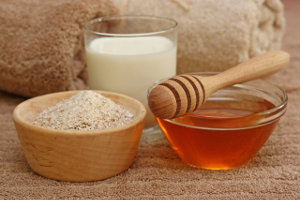 You can also make a mask at home with common kitchen ingredients like oatmeal and honey. Oatmeal is an excellent soothing ingredient that reduces inflammation. Oat is found in many sensitive skin products. (NOTE: If you’re allergic to gluten, you can’t use oatmeal.) Honey is also soothing and offers other great benefits – it’s hydrating, anti-bacterial, anti-inflammatory, and non-comedogenic too.
You can also make a mask at home with common kitchen ingredients like oatmeal and honey. Oatmeal is an excellent soothing ingredient that reduces inflammation. Oat is found in many sensitive skin products. (NOTE: If you’re allergic to gluten, you can’t use oatmeal.) Honey is also soothing and offers other great benefits – it’s hydrating, anti-bacterial, anti-inflammatory, and non-comedogenic too.
The recipe doesn’t even really matter that much. Just mix some cooked oatmeal (cold, not hot) and honey together in whatever ratio you feel like. I would focus more on the oats.
Leave it on for 10-20 min.
12. Wear sunscreen containing Zinc Oxide
If your skin is damaged, it is more vulnerable to sun damage. The sun’s rays will exacerbate your irritation. So it’s important to wear sunscreen. (It always is but especially now!)
Use a sunscreen with Zinc Oxide. Not only is it the best active ingredient in sunscreen, but it is also an effective anti-inflammatory ingredient. Zinc Oxide will soothe your skin. (This is what lifeguards put on their nose.)
13. Avoid heat
Heat increases circulation, which is exactly what you don’t want if your skin is already irritated and inflamed. Heat will make it worse.
So avoid taking hot showers or baths. Bathe at lukewarm temperatures. Naturally, don’t use a steam room, sauna, or jacuzzi.
Also avoid being outside in the sun.
14. Avoid manipulating skin (no rubbing or massaging)
Rubbing or massaging skin increases circulation too. So use very gentle motions when applying skincare. Keep it brief, don’t massage into skin.
Skip any sort of facial massage too.
Try not to touch the area where you are affected.
What To Do If Nothing’s Helping
If your skin is still irritated after a few days, it’s bothering you, and there is no sign of it getting better, it’s time to see a doctor.
You could have an infection that requires medical attention, or a bad case of inflammation that requires cortisone injections or prescription strength medication.

